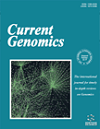- Home
- A-Z Publications
- Current Genomics
- Previous Issues
- Volume 12, Issue 3, 2011
Current Genomics - Volume 12, Issue 3, 2011
Volume 12, Issue 3, 2011
-
-
Editorial [Hot Topic: Genomics of Childhood Obesity (Guest Editor: Merlin G. Butler)]
More LessGenomics of childhood obesity is an important and timely topic for investigators to better understand the role of gene function in the causation of childhood obesity, a significant health problem affecting much of westernized societies. Genetic abnormalities account for much of childhood obesity, syndromic and non-syndromic. Completion of the Human Genome Project and availability of genome sequencing data along wit Read More
-
-
-
Molecular Basis of Obesity: Current Status and Future Prospects
More LessAuthors: Helene Choquet and David MeyreObesity is a global health problem that is gradually affecting each continent of the world. Obesity is a heterogeneous disorder, and the biological causes of obesity are complex. The rapid increase in obesity prevalence during the past few decades is due to major societal changes (sedentary lifestyle, over-nutrition) but who becomes obese at the individual level is determined to a great extent by genetic susceptibility. In this re Read More
-
-
-
Genetics of Obesity: What have we Learned?
More LessAuthors: Helene Choquet and David MeyreCandidate gene and genome-wide association studies have led to the discovery of nine loci involved in Mendelian forms of obesity and 58 loci contributing to polygenic obesity. These loci explain a small fraction of the heritability for obesity and many genes remain to be discovered. However, efforts in obesity gene identification greatly modified our understanding of this disorder. In this review, we propose an overloo Read More
-
-
-
Gene-Diet Interactions in Childhood Obesity
More LessChildhood overweight and obesity have reached epidemic proportions worldwide, and the increase in weightassociated co-morbidities including premature type 2 diabetes mellitus (T2DM) and atherosclerotic cardiovascular disease will soon become major healthcare and economic problems. A number of studies now indicate that the childhood obesity epidemic which has emerged during the past 30 years is a complex multi-fa Read More
-
-
-
Structural Chromosome Abnormalities Associated with Obesity: Report of Four New Subjects and Review of Literature
More LessAuthors: Majed J. Dasouki, Erin L. Youngs and Karine HovanesObesity in humans is a complex polygenic trait with high inter-individual heritability estimated at 40-70%. Candidate gene, DNA linkage and genome-wide association studies (GWAS) have allowed for the identification of a large set of genes and genomic regions associated with obesity. Structural chromosome abnormalities usually result in congenital anomalies, growth retardation and developmental delay. Occasionally, Read More
-
-
-
Prader-Willi Syndrome: Obesity due to Genomic Imprinting
More LessPrader-Willi syndrome (PWS) is a complex neurodevelopmental disorder due to errors in genomic imprinting with loss of imprinted genes that are paternally expressed from the chromosome 15q11-q13 region. Approximately 70% of individuals with PWS have a de novo deletion of the paternally derived 15q11-q13 region in which there are two subtypes (i.e., larger Type I or smaller Type II), maternal disomy 15 (both 15 Read More
-
-
-
Fragile X Syndrome
More LessAuthors: Yingratana McLennan, Jonathan Polussa, Flora Tassone and Randi HagermanRecent data from a national survey highlighted a significant difference in obesity rates in young fragile X males (31%) compared to age matched controls (18%). Fragile X syndrome (FXS) is the most common cause of intellectual disability in males and the most common single gene cause of autism. This X-linked disorder is caused by an expansion of a trinucleotide CGG repeat (>200) on the promotor region of the fragile X m Read More
-
-
-
Alstrom Syndrome: Genetics and Clinical Overview
More LessAuthors: Jan D. Marshall, Pietro Maffei, Gayle B. Collin and Jurgen K. NaggertAlstrom syndrome is a rare autosomal recessive genetic disorder characterized by cone-rod dystrophy, hearing loss, childhood truncal obesity, insulin resistance and hyperinsulinemia, type 2 diabetes, hypertriglyceridemia, short stature in adulthood, cardiomyopathy, and progressive pulmonary, hepatic, and renal dysfunction. Symptoms first appear in infancy and progressive development of multi-organ pathology lea Read More
-
Volumes & issues
-
Volume 26 (2025)
-
Volume 25 (2024)
-
Volume 24 (2023)
-
Volume 23 (2022)
-
Volume 22 (2021)
-
Volume 21 (2020)
-
Volume 20 (2019)
-
Volume 19 (2018)
-
Volume 18 (2017)
-
Volume 17 (2016)
-
Volume 16 (2015)
-
Volume 15 (2014)
-
Volume 14 (2013)
-
Volume 13 (2012)
-
Volume 12 (2011)
-
Volume 11 (2010)
-
Volume 10 (2009)
-
Volume 9 (2008)
-
Volume 8 (2007)
-
Volume 7 (2006)
-
Volume 6 (2005)
-
Volume 5 (2004)
-
Volume 4 (2003)
-
Volume 3 (2002)
-
Volume 2 (2001)
-
Volume 1 (2000)
Most Read This Month
Article
content/journals/cg
Journal
10
5
false
en


